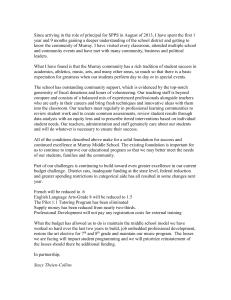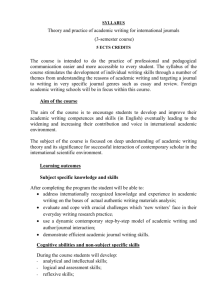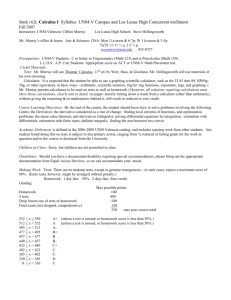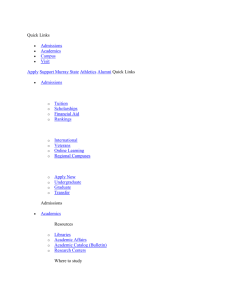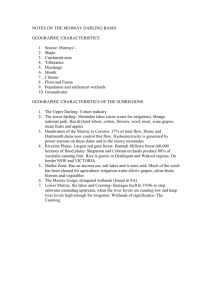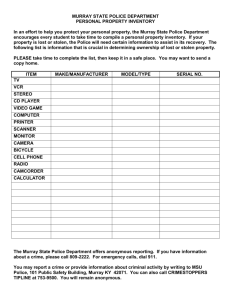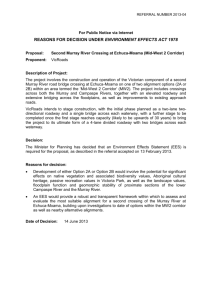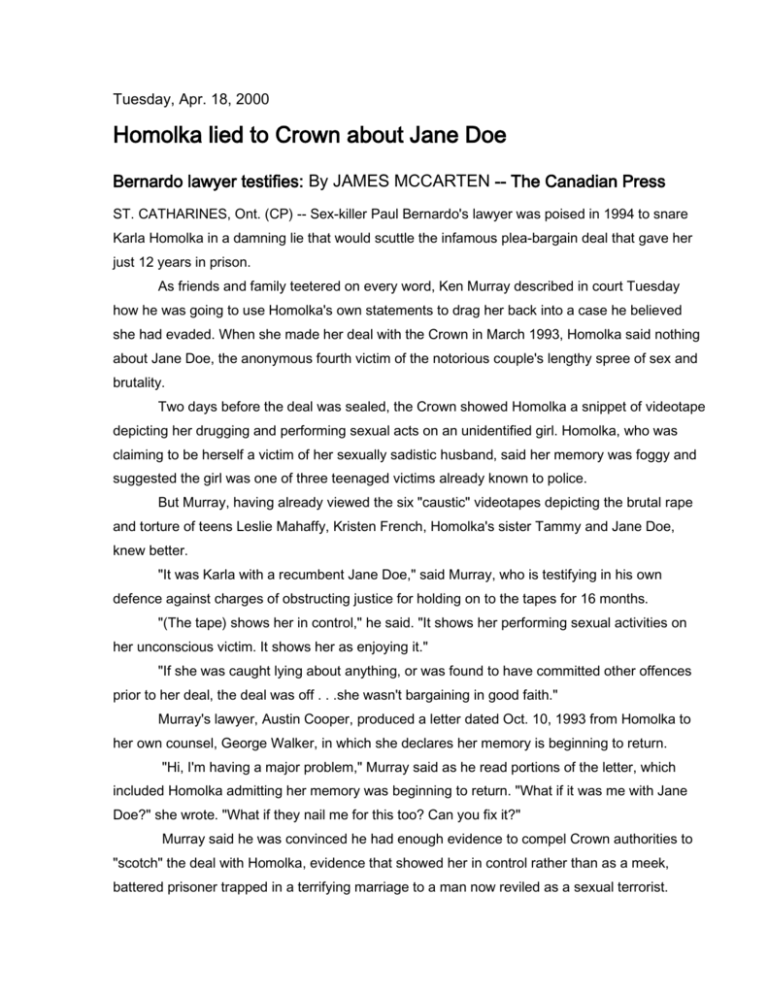
Tuesday, Apr. 18, 2000
Homolka lied to Crown about Jane Doe
Bernardo lawyer testifies: By JAMES MCCARTEN -- The Canadian Press
ST. CATHARINES, Ont. (CP) -- Sex-killer Paul Bernardo's lawyer was poised in 1994 to snare
Karla Homolka in a damning lie that would scuttle the infamous plea-bargain deal that gave her
just 12 years in prison.
As friends and family teetered on every word, Ken Murray described in court Tuesday
how he was going to use Homolka's own statements to drag her back into a case he believed
she had evaded. When she made her deal with the Crown in March 1993, Homolka said nothing
about Jane Doe, the anonymous fourth victim of the notorious couple's lengthy spree of sex and
brutality.
Two days before the deal was sealed, the Crown showed Homolka a snippet of videotape
depicting her drugging and performing sexual acts on an unidentified girl. Homolka, who was
claiming to be herself a victim of her sexually sadistic husband, said her memory was foggy and
suggested the girl was one of three teenaged victims already known to police.
But Murray, having already viewed the six "caustic" videotapes depicting the brutal rape
and torture of teens Leslie Mahaffy, Kristen French, Homolka's sister Tammy and Jane Doe,
knew better.
"It was Karla with a recumbent Jane Doe," said Murray, who is testifying in his own
defence against charges of obstructing justice for holding on to the tapes for 16 months.
"(The tape) shows her in control," he said. "It shows her performing sexual activities on
her unconscious victim. It shows her as enjoying it."
"If she was caught lying about anything, or was found to have committed other offences
prior to her deal, the deal was off . . .she wasn't bargaining in good faith."
Murray's lawyer, Austin Cooper, produced a letter dated Oct. 10, 1993 from Homolka to
her own counsel, George Walker, in which she declares her memory is beginning to return.
"Hi, I'm having a major problem," Murray said as he read portions of the letter, which
included Homolka admitting her memory was beginning to return. "What if it was me with Jane
Doe?" she wrote. "What if they nail me for this too? Can you fix it?"
Murray said he was convinced he had enough evidence to compel Crown authorities to
"scotch" the deal with Homolka, evidence that showed her in control rather than as a meek,
battered prisoner trapped in a terrifying marriage to a man now reviled as a sexual terrorist.
"It was clear in my view that she knew exactly who it was and had known from the beginning,"
Murray testified. "She was trying to intervene and protect herself."
On Monday, Murray testified about how he had planned to confront Homolka at any one
of several expected preliminary hearings scheduled variously during the spring and summer of
1994. But in the space of a month, all of them were cancelled by government authorities, who
wanted to fast-track a trial that had already been severely delayed.
On Tuesday, he suggested the hearings were cancelled intentionally because Homolka
simply wasn't ready to be cross-examined, despite documents that showed Crown officials had
spent more than a month trying to get her ready to testify.
Murray was the first person other than either Bernardo or Homolka to view the infamous
tapes, which he plucked from the ceiling of the pair's quaint clapboard home in a tony St.
Catharines suburb in May 1993.
Murray has testified that Bernardo was ashamed of his actions on the tapes, but freely
admitted beating and brutally raping Mahaffy and French. He was adamant that it was Homolka
who killed the girls, prompting Murray's team to build what they dubbed the "black widow"
defence: portray Karla as the deceptive, calculating killer and get "vindication" for Bernardo.
The plan was to use the tapes to discredit Homolka's "unconscionable" deal with the
Crown, which gave her 12 years in prison on two manslaughter charges in exchange for
testimony against her former husband.
Throughout his testimony, Murray has insisted he didn't believe he had to turn the tapes
over to authorities, especially since he hadn't viewed them and assumed they were only
incriminating to Homolka.
Murray's delay in handing over the tapes is thought to have allowed Homolka to make her
much maligned deal with the Crown. A judicial inquiry found that had authorities seen the
videotapes, a deal with Homolka would not have been necessary.
1. Prior to the discovery of the videotapes,
the Crown believed that Homolka’s
testimony was necessary to convict
Bernardo. Given this situation, was the
plea bargain a reasonable agreement for
both Homolka and the Crown? Explain.
2. When the tapes were made available to
the Crown, no further charges were
made against Homolka. In your opinion,
what would be the effect on future plea
bargains if the Crown attempted to
prosecute her on further charges in spite
of their agreement?
3. What circumstances would have
been necessary for the Crown to void
the Homolka plea bargain?
4. “Usually, the plea bargain is offered to
the lesser players in the crime, in order
to secure a conviction of the more
important accused.” Do you think this
scenario played out in the Homolka plea
bargain? Why was she thought to be a
lesser player in the crime? Explain your
answer.
5. Did the Homolka plea bargain make it
impossible for the Bernardo lawyers to
mount a legitimate defence to the
charges against him? Explain.
6. “Criminal law is the collective property of
all citizens. It is not the private domain of
the legal profession and the courts. Any
justice system that is completely
insensitive to public concerns and needs
would constitute a tyranny.” Discuss this
quotation in the context of the Homolka
plea bargain.

